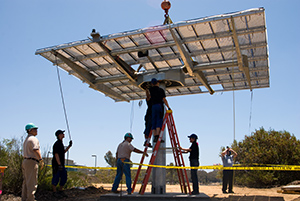Jul 27 2009
The University of California, San Diego has begun producing electricity with newly installed solar panels made by Concentrix Solar that automatically track the sun as it crosses the daytime sky and concentrates sunlight onto hundreds of electricity-producing solar cells, each smaller than a shirt button.
 Workers install Concentrix Solar’s sun-tracking concentrating photovoltaic panel at UC San Diego’s East Campus Energy Complex
Workers install Concentrix Solar’s sun-tracking concentrating photovoltaic panel at UC San Diego’s East Campus Energy Complex
The 220-square-foot, 5.75-kilowatt concentrating photovoltaic (CPV) panel mounted on a movable platform atop a metal pole at UC San Diego’s East Campus Energy Complex was installed by Concentrix Solar, a German CPV technology manufacturer. Concentrix Solar’s new CX-75 technology has an average efficiency of 27.2 percent, or nearly twice that of conventional photovoltaic technology. The technology is used in a commercial power plant in Spain, and the company will use the UC San Diego project to demonstrate the technology’s potential to U.S. customers while donating the electricity generated to the university.
“UC San Diego is an ideal partner because it has years of experience in the field of photovoltaics and was one of the first American universities to install PV systems for their own use in a big way,” said Concentrix Solar project leader Inka Heile. “In addition, the site of the demonstration system situated at UC San Diego’s East Campus Energy Complex is close to the international airport and very accessible for our customers.”
The new Concentrix Solar CPV panels are a small part of a much larger 1 megawatt photovoltaic system previously installed on rooftops and parking garages at UC San Diego. The university plans to install a second megawatt of photovoltaic capacity and also is planning to install a 2.8-megawatt fuel cell that by 2010 will begin converting methane gas recovered from the city of San Diego’s Point Loma Wastewater Treatment Plant directly into electricity.
“UC San Diego is in the midst of an aggressive effort to add alternative energy as part of our Sustainability 2.0 initiative, and this new photovoltaic project fits right into the mix,” said Steve Relyea, vice chancellor for business affairs. ”Our Sustainability 2.0 initiative includes developing the UC San Diego campus into a living laboratory for cutting-edge solutions to climate change.”
UC San Diego faculty and students will be able to access a record of all the electricity produced by the Concentrix panels for their research purposes.
Much of the solar research at UC San Diego is being led by the Jacobs School of Engineering, which has world-renowned experts on photovoltaics, nanotechnology, green computing and weather monitoring. The Jacobs School’s Center for Energy Research is collaborating with UC Davis on a two-year, $700,000 grant from the California Energy Commission to expand the development and use of solar energy in the state. The researchers are tracking the evolving landscape of solar technology development and use in California in order to help the state achieve an ambitious goal of installing 3,000 megawatts of solar energy capacity in California by 2017.
“The Jacobs School of Engineering is helping UC San Diego become a leader in developing sustainable solutions for society,” said Frieder Seible, dean of the Jacobs School. “The Solar Energy Collaborative is one example of our commitment to boost the creation and use of renewable energies. The Jacobs School installed the first photovoltaic arrays on the Powell Structural Research Lab in 2006 with a public LED display to continuously remind the campus community about sustainable and renewable energy contributions.”
In order to help meet its carbon-neutral goal, UC San Diego also is in the process of converting its 800-vehicle fleet of cars, trucks and other vehicles into low- and zero-emission models that eventually will rely on renewable fuels only. Energy consumption by the university’s existing buildings also is being reduced and new buildings are being constructed with the latest energy- and water-savings technologies.
The aim of the joint Concentrix Solar-UC San Diego project is to test the new module’s power output under California climate conditions and thus to create a reference in the U.S., especially for American customers.
By means of Fresnel lenses, the Concentrix Solar panel focuses sunlight onto small highly efficient triple-junction solar cells based on a germanium substrate. These solar cells convert the sunlight, concentrated 500 times, directly into electrical energy. With this technology, system efficiencies can be achieved that are almost twice as high as those achieved by conventional silicon PV technology.
Concentrix Solar GmbH was founded in February 2005 as a spin-off company of the Fraunhofer Institute for Solar Energy Systems ISE. Concentrix Solar manufactures its modules in Freiburg, Germany, but the company is considering expanding its manufacturing operations in the U.S.